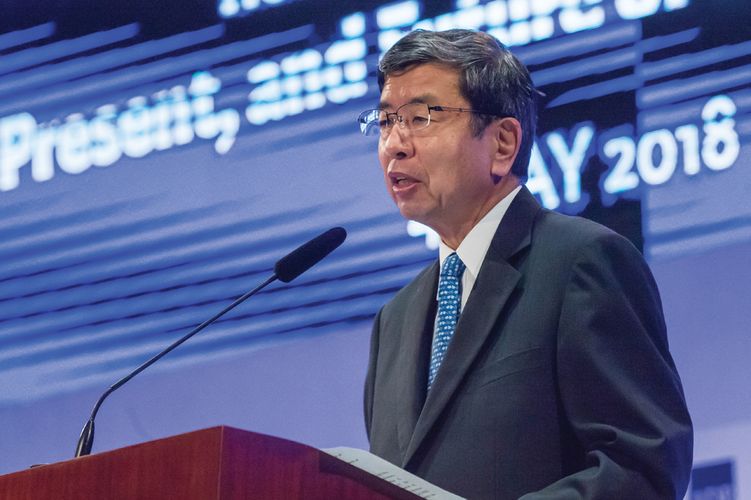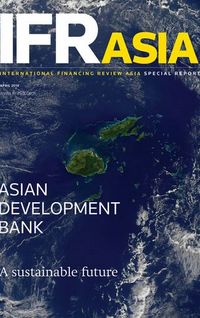After winning support for his vision for the next decade last year, ADB President Takehiko Nakao is building consensus around changes to loan pricing and concessional funding.
Fiji, the host of the Asian Development Bank’s 2019 annual meetings, is a fitting illustration of the challenges facing the bank.
Much like the ADB itself, the Pacific Island nation needs to respond to climate change and is pushing to enhance its relevance in an increasingly globalised world. It is looking to benefit from improved technology and connectivity across the region, but also faces challenges integrating a diverse population and ensuring its growth is sustainable.
“Many of these issues are more salient in the Pacific countries,” said Takehiko Nakao, ADB President. “These are challenges and opportunities for Asia, but the scale of the economies and their remoteness means it is more clearly seen in these countries.”
Nakao’s vision for the ADB’s next decade – formalised last year in a painstakingly crafted policy document, Strategy 2030 – could easily have been written with Fiji in mind. Poverty reduction is still the bank’s overriding objective, but the plan also calls for the ADB to do more for the least developed countries in its membership, address climate change and improve resilience against natural disasters – among other goals.
For Nakao, the fact that Fiji is hosting the 2019 meetings is a sign of the ADB’s engagement with smaller countries.
“I hope we can showcase the development and opportunities in the Pacific Island countries, and also the challenges,” he said.
The strategic changes are evolutionary, rather than revolutionary, for the 52-year old institution, but they point to shifting demands from its shareholders after decades of rapid growth in the region.
The 2030 plan gives more weight to frontier markets and social issues, calling for work to improve life in Asia’s rapidly expanding cities, and enhance education and health services. It also demands more innovative financial instruments and more partnerships, with defined targets for the amount of funds mobilised through cofinancing, for example.
Nakao wants the bank to become a far more commercial institution by 2030, with a far bigger private sector balance sheet. Having won agreement from its 67 member countries (now 68, after Niue joined in March) at the 2018 annual meetings, he is now pressing ahead with putting those plans into action.
Getting there, however, could be the ADB’s biggest challenge yet.
New tools
The long-term goal will require some fundamental changes to the way the ADB operates. The use of grants is a case in point: as more Asian economies graduate to middle-income and higher-income status, the ADB’s existing framework dictates that they are no longer entitled to handouts. Only a handful of countries, such as Afghanistan and the Pacific Islands, still qualify.
Some donors see that as a missed opportunity, since the funds could still have a big impact even in relatively richer countries – through disaster risk management, tackling diseases or improving opportunities for women, for instance, rather than financing power plants or highways.
“In Asia the role of grants is diminishing,” said Nakao. “Do we reduce grant operations, or can we use grants for other purposes for regional public good, such as communicable diseases?”
The 13th replenishment of the Asian Development Fund – now a grant-only operation – will be under discussion at the Fiji meetings, ahead of the expiry of ADF 12 in 2020.
Nakao believes grants could be combined with the ADB’s regular loans in some more developed countries, for instance to promote gender equality through additional training or capacity building. Any changes, however, will need the full support of ADF donors, who are keen for their funds to support the most vulnerable populations.
“There are many elements we can support by blending grants with loans,” said Nakao. “We must start thinking about the goal of the concessional window.”
Using development funds for richer countries has become a hot topic in the global community, especially with the change in leadership in the US-based World Bank. US Treasury secretary Stephen Mnuchin has been an outspoken critic of the World Bank group’s lending to middle-income countries – especially China – although newly installed president David Malpass has cooled talk of further reforms since his appointment was confirmed in April.
Nakao has no intention of ruling out ADB loans to China, believing that the bank can still play an important role in countries that no longer need its money.
“Our argument is that it is better for the ADB to engage China through lending operations – maybe not forever, but at least for some time,” said Nakao. “China is already a higher-income country compared to others and has market access, but there is still an advantage to continue to lend to strengthen institutions, address climate change and inclusive development.”
Loan pricing reform
A bigger structural change is also beginning to take shape. After the World Bank committed to move to differentiated lending rates – in part to secure support for its 2018 capital increase – the ADB has also tabled reforms to loan pricing.
The idea would involve charging more for loans to more developed countries, which still value the work of multilateral lenders but no longer need to rely on a development bank for cheap funding.
The World Bank’s new model – effective as of July 2018 – applies a different maturity premium to long-term loans depending on the borrowing country’s classification. Rather than a flat 10bp–50bp premium depending only on maturity, high-income countries now pay 15bp–115bp over the bank’s base lending rate – an additional 65bp at the longest tenors.
The ADB’s approach is not yet formalised, although the 2030 document does call for a review of “various options to generate organic capital growth” and “the possibility of diversifying the financing terms of its products and instruments”.
The ADB does not have the same urgency as the World Bank, which needed to secure support for its capital raising from an obstructive US administration, but it is likely to face similar pressures in the longer term.
Nakao emphasises that the bank is not being pressed into reform – and has no immediate plans for a capital increase – but he says the idea of differentiated borrowing terms has been under discussion for some time.
“We need to act more proactively to address these issues otherwise not many shareholders will continue to support our operations in countries like China,” he said. “We should also respond to the changing conditions and circumstances in the world.”
Just as Asian countries have come a long way since the ADB was set up in 1966, many shareholders in the developed world are facing their own challenges, with Europe grappling with slow economic growth and Brexit, and the US reducing its support for multilateral institutions under a disinterested president.
“We want to avoid a repeated capital increase,” said Nakao. “Generally we should aim at a more organic, sustainable financing model.”
Private sector growth
The expansion of the ADB’s private sector operations will also boost its revenues, as well as satisfy calls to reduce Asia’s dependence on public sector financing for growth.
While the bulk of the bank’s portfolio is sovereign lending, at a flat rate of 50bp over Libor, private sector disbursements are done on commercial terms.
The ADB has committed to expand its private sector programmes to one third of all operations by number by 2024.
Mobilising additional resources will also be a key focus, with every US$1 of private sector financing to be matched by US$2.50 of long-term cofinancing by 2030.
The expansion of the private sector department brings with it a number of organisational changes. To mobilise more local funds, the ADB will provide more support in local currencies and do more to support local capital markets in the region. It will also roll out more innovative financing tools that are more relevant to private sector clients, and increase its exposure to equity and alternative investments.
This will expose the bank to more risk, especially as it increases its operations in frontier markets at the same time.
Nakao says the ADB is adding to its risk management expertise and reviewing its approach to private sector loans and equity investments.
“In the case of loans … we are proposing a kind of portfolio approach. If we look at each case very closely we cannot invest. It’s very difficult to tell the risk and pricing,” he said. “We must think about the portfolio as a collection of investments as a whole.”
The bank will also study the best time for equity investments – at the point of an IPO or earlier – to increase the impact of the ADB’s resources while managing its exposure.
“Equity investment is generally riskier, but there is also upside,” he said. “The idea is we are not seeking profit per se, but if we lose money it is a sign that it’s not working.”
New ways of working
A bigger private sector book of business will also require investment in people.
Less than 10% of the ADB’s 3,374 staff work in the private sector department, and, while thematic groups aim to spread sector-specific expertise across the institution, it will need to upskill its workforce to add risk managers, commercial pricing expertise and new technology.
This challenge extends across the bank’s entire operations.
“Under Strategy 2030 we are talking about more advanced technologies,” said Nakao. “To do that, we need new talent with new ideas.”
Nakao believes that a more flexible approach to employment will enhance the bank’s chances of attracting, and retaining, top talent.
The expansion of the ADB’s network of field offices (resident missions, in ADB parlance), will bring it closer to clients and help originate more projects – especially in the private sector – but it also offers employment opportunities outside of its Manila headquarters. While the ADB has never noticed a shortage of candidates for any open position, department heads do admit it is often a challenge to convince a sector expert to move their spouse and children to the Philippines.
Fiji, again, is a case in point. As well as the logistics of serving remote Pacific Island nations from the bank’s Manila base, the greenhouse gas emissions from air transport are a blot on the bank’s own green agenda.
The answer for Nakao lies in partnerships, whether it means Australia providing staff for a sub-regional office or accessing concessional climate funds to complement the ADB’s own resources.
The 2019 annual meetings are, then, an opportunity to enhance cooperation and partnerships that will lift the ADB’s importance to Asia, and Asia’s role in the world.
“We want to keep this bank relevant to the ADB’s customers,” he said. “Our work to promote the spirit of collaboration between countries … this is really important.”
To see the digital version of this roundtable, please click here
To purchase printed copies or a PDF of this report, please email gloria.balbastro@tr.com



